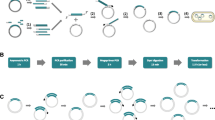Abstract
cDNA cloning has proven to be an indispensable tool for elucidating the structure, organization and expression of eukaryotic genes. It has also been essential for synthesizing foreign proteins in heterologous hosts, providing coding sequence of a gene of interest. In the future this technology will undoubtedly assume an ever expanding role in both science and commerce. cDNA libraries constructed by classical methods contain a population of cDNAs in which the inserts of a given species have widely varying lengths. Isolation of a full-length cDNA requires repeated screening of the library, or more usually, the full-length cDNA is reconstructed from partial length cDNAs. There have been continuing efforts to modify the technology in order to produce full-length cDNAs from mRNAs of large size (larger than 4 kb) and low abundance (less than 0.01%). Even so, it has been difficult until recently to isolate cDNA representing a complete copy of an intact mRNA, especially when it is to be cloned from a tissue rich in nuclease or when the mRNA is very large (more than 5 kb). Recently we have constructed a cDNA library from adult rat pancreas and isolated cDNA clones which encode the lysophospholipase mRNAs from cap to polyA site, 2.1 kb in length (1). In this same library, the majority of other cDNA clones (more than 80% tested) are full-length copies as well. During this work we have made significant modifications to the existing methodology for cDNA cloning. This includes an improvement in the procedures for isolation of intact RNA, and modification for directional cDNA cloning using primer-adapters and finally optimization of lambda vectors. A combination of these modifications not only allows construction of a full-length cDNA library but also provides other valuable applications, for example, an effective method to screen the library in a subtractive manner. This chapter provides the details of the modifications and discusses the implications of up-to-date directional cDNA cloning techniques. The strategy described here is especially helpful for isolating rare gene products which are difficult to purify by conventional biochemical means.
Access this chapter
Tax calculation will be finalised at checkout
Purchases are for personal use only
Preview
Unable to display preview. Download preview PDF.
Similar content being viewed by others
References
Han, J.H., Stratowa, C. and Rutter, W.J. (1987) Biochemistry 26, 1617–1625.
Barlow, J.J., Mathias, A.P. and Williamson, R. (1963) Biochem. Biophys. Res. Commun. 13, 61–66.
Chirgwin, J., Przybyla, A.E., MacDonald, R.J. and Rutter, W.J. (1979) Biochemistry 18, 5294–5299.
Young, R.A. and Davis, R.W. (1983) Proc. Nat. Acad. Sci. U.S.A. 80, 1194–1198.
Young, R.A. and Davis, R.W. (1983) Science 222, 778–782.
Smith, G.R., Kunes, S.M., Shultz, D.W., Taylor, A. and Triman, K. L. (1981) Cell 24, 429–436.
Han, J.H. and Rutter, W.J. (1987) Nucl. Acids Res. 15, 6304.
Maniatis, T., Fritsch, E.F. and Sambrook, J. (1982) Molecular Cloning, A Laboratory Manual, Cold Spring Harbor Laboratory, Cold Spring Harbor Press, N.Y.
Sambrook, J., Fritsch, E.F. and Maniatis, T. (1988) Molecular Cloning, A Laboratory Manual, 2nd edition (in press).
Okayama, H. and Berg, P. (1982) Mol. Cell. Biol. 2, 161–170.
Gubler, U. and Hoffman, J. (1983) Gene 25, 263–269.
Land, M., Grez, M., Hansen, H., Lindermaier, W. and Schuetz, G. (1981) Nucl. Acids Res. 9, 2251–2266.
Krawinkel, U. and Zoebelein, R. (1986) Nucl. Acids Res. 14, 1913.
Truett, M.A., Blacher, R., Burke, R.L., Caput, D., Chu, C., Dina, D., Hartog, K., Kuo, C.H., Masiarz, F.R., Merryweather, J.P., Najarian, R., Pachl, C., Potter, S.J., Puma, J., Quiroga, M., Rall, L.B., Randolph, A., Urdea, M.S., Valenzuela, P., Dahl, H.H., Favalaro, J., Hansen, J., Nordfang, O. and Ezban, M. (1985) DNA 4, 333–349.
Palazzolo, M.J. and Meyerowitz, E.M. (1987) Gene 52, 197–206.
Bellemare, G., Potvin, C., Simard, C. and Larouche, L. (1987) Gene 52, 11–19.
Coleclough, C. and Erlitz, F.L. (1985) Gene 34, 305–314.
Cathala, G., Savouret, J., Mendez, B., West, B., Karin, M., Martial, J. and Baxter, J. (1985) DNA 2, 329–335.
Pelham, H.F.B. and Jackson, R.J. (1976) Eur. J. Biochem. 67, 247–266.
Aviv, H. and Leder, P. (1972) Proc. Nat. Acad. Sci. U.S.A. 69, 1408–1412.
MacDonald, R.J., Swift, G.H., Przybyla, A.E. and Chirgwin, J. (1987) Methods Enzymol. 152 (in press).
Melton, D.A., Krieg, P.A., Rebagliati, M.R., Maniatis, T., Zinn, K. and Green, M.R. (1984) Nucl. Acids Res. 12, 7035–7057.
Nielsen, D.A. and Shapiro, D.J. (1986) Nucl. Acids Res. 14, 5936.
Laemmli, U.K. (1970) Nature 227, 680–685.
Author information
Authors and Affiliations
Editor information
Editors and Affiliations
Rights and permissions
Copyright information
© 1988 Plenum Press, New York
About this chapter
Cite this chapter
Han, J.H., Rutter, W.J. (1988). Isolation of Intact mRNA and Construction of Full-Length cDNA Libraries: Use of a New Vector, λgt22, and Primer-Adapters for Directional cDNA Cloning. In: Setlow, J.K. (eds) Genetic Engineering. Genetic Engineering, vol 10. Springer, Boston, MA. https://doi.org/10.1007/978-1-4615-7081-3_11
Download citation
DOI: https://doi.org/10.1007/978-1-4615-7081-3_11
Publisher Name: Springer, Boston, MA
Print ISBN: 978-1-4615-7083-7
Online ISBN: 978-1-4615-7081-3
eBook Packages: Springer Book Archive




